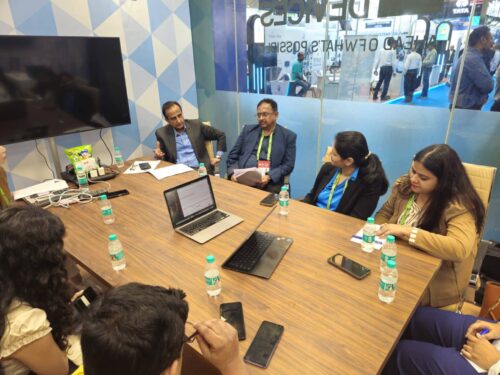
A billion mobile users, slow fibre rollout, and India’s mmWave leap, that is exactly how Analog Devices and its telecom partners are transforming high-speed broadband through next-gen wireless connectivity.

India’s mobile user base has crossed a billion, and most of us rely on mobile data for streaming and social media. But when it comes to work from home, online classes, or telemedicine, we all know how frustrating unstable internet speeds can be. These applications need broadband speeds above 100 Mbps, something fibre-to-home (FTTH) networks can easily deliver. The problem is, setting up fibre in cities has been painfully slow. Permissions from municipalities, restrictions from housing societies, and the mess of overhead wires make installation both costly and time-consuming.
Recently, the Government of India has opened up the FR2 band (26–27GHz), a high-frequency range that can transmit large amounts of data wirelessly. Instead of running fibre cables to every home, telecom companies can now beam data to small rooftop receivers on apartment buildings. These receivers then send the signal through Ethernet or Wi-Fi routers, giving us speeds between 100 and 300 Mbps without digging roads or waiting for local approvals.
At the ninth India Mobile Congress (IMC 2025), Analog Devices India (ADI) hosted a media roundtable to discuss these new broadband possibilities. It was a good opportunity to hear directly from Vivek Tyagi, the Managing Director of ADI, and understand how the company is supporting this shift toward wireless broadband.
What stood out for me was the discussion on how mmWave broadband is already shaping the next phase of India’s connectivity. We have seen BSNL launch a 4G network built entirely on Indian technology, and now companies like ‘Jio AirFiber’ and ‘Airtel Xstream AirFiber’ are taking it further using mmWave.
Vivek said, “We support these rollouts with RF 3D frequency chips and reference designs that make the setup process much faster.” Normally, wired broadband installations can take days, but with this wireless approach, it can happen within hours. For consumers like us, that means quicker connections. For telecom companies, it means faster revenue generation and better broadband adoption across India.
Extending fibre where needed
“Millimetre wave broadband is not here to replace optical fibre. It is meant to complement it by extending high-speed coverage where laying fibre is difficult,” added Vivek. Early deployments use unlicensed spectrum for moderate-density areas, and future rollouts will move to licensed bands for higher capacity and reliability. Fibre remains the backbone, and mmWave helps us get that last-mile connection faster.
“We are working on 6G-ready mmWave RF modules that can plug into different motherboards. Once we validate them, we will show them to telecom operators and global equipment makers. Being present in Taiwan also allows us to partner with major OEMs, supporting both local and international markets,” disclosed Vivek.
The cost and infrastructure advantages are clear. Existing telecom towers can host mmWave modules with minimal changes, adding one more box to deliver high-speed connectivity. Compared to extending fibre to every home, this is more economical and makes large-scale deployment possible. Vivek said, “Urban clusters like Noida, Gurugram, and Bengaluru are suitable for mmWave, while rural areas will continue to rely on optical fibre.”
India’s mmWave leap
When someone asked about the material used, Vivek said, “Material choice matters in mmWave systems. Gallium Nitride (GaN) is used for high-power RF applications above 20 watts. For lower-power designs, we manage the entire RF signal chain internally, avoiding external GaN components. This gives more control over design, cost, and production.”
We also learned that India’s telecom manufacturing is expanding. Collaborations between chip designers, OEMs, and system integrators enable local manufacturers like VBT and Bajaj Network to use in-house RF chipsets to build complete equipment systems. Indian companies can act as design manufacturers or telecom vendors, strengthening the domestic ecosystem under the Make-in-India initiative.
Explaining the use of the mmWave technology, Vivek added, “This technology is not just for broadband. It supports industrial IoT in sectors like cement, power, and chemicals, where real-time data is needed for automation. Its low latency and high speed enable smart manufacturing and connected infrastructure. The RF modules include programmable elements like FPGAs for integration with motherboards.”
Academic institutions like IIT Madras and IIT Hyderabad are already acting as testbeds for developing and validating high-frequency RF technologies. We also heard that discussions are underway to explore the 60 GHz spectrum, which could support future 6G applications. Existing RF components, such as the Apollo product line operating up to 20 GHz, can be extended to higher frequencies as standards evolve.
As India moves toward smart cities, mmWave broadband is expected to become a crucial layer of connectivity. Once telecom operators validate the technology, it will be integrated through partnerships with equipment vendors and system integrators working on smart city infrastructure. With government support, research collaborations, and growing broadband demand, we can see India’s telecom ecosystem gearing up for the next era of connectivity. Millimetre wave (mmWave) technology could become a cornerstone for delivering fast, scalable, and locally developed broadband solutions, helping strengthen India’s position in the global telecom landscape.

